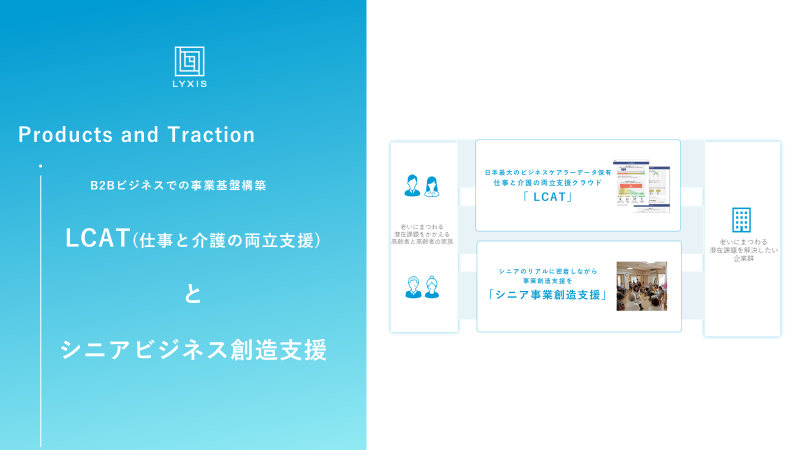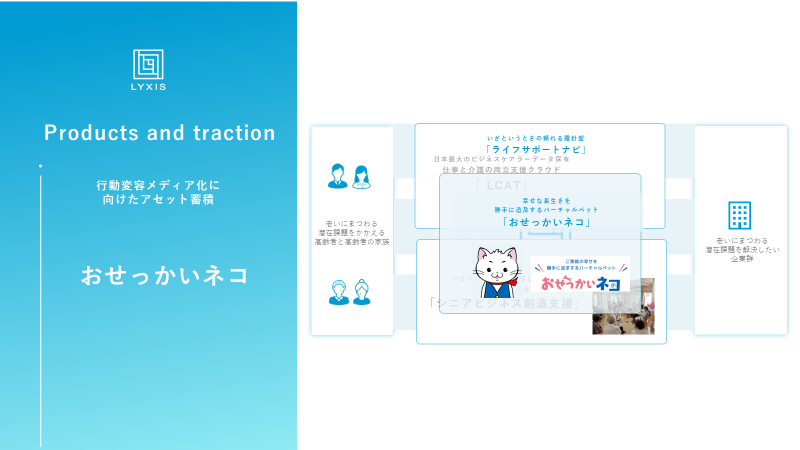Hiroko Sasaki, Founder & CEO of Lyxis Co., Ltd.
The aging of Japan’s population will further accelerate, rapidly increasing the number of people aged 80 and older. While the market for seniors is expected to be worth 100 trillion yen by 2025, the population of the working generation will rapidly decrease. Many workers are now concerned about balancing work and taking care of their older family members. Lyxis Co., Ltd. is a company that understands in-depth the reality of seniors and is working to resolve issues related to aging. Ms. Hiroko Sasaki, Founder & CEO of the company, talked about its feature activities.

Founder & CEO of Lyxis Co., Ltd.
―In Japan, where the population is aging rapidly, you are developing a business of solving problems for the elderly and their families. What is the background of your business?
While many other countries in the world are starting to see an acceleration of the aging of their populations, Japan is 20 years ahead of China and 40 years ahead of Europe and the United States in terms of the ratio of senior citizens. In fact, the segment that will grow the most in Japan from now on will be people in their 80s and older. The Japanese government feels that there are limits to the Japan’s welfare system for seniors, a public assistance system, because it will swell to 190 trillion yen if the situation continues. Therefore, the government intends to promote self-help and mutual assistance in the future aging society.
At the same time as these issues, the population of the working generation will drastically decrease. It’s a generation with a declining birth rate, so people also don’t have many siblings. It’s also a generation where both husband and wife have jobs, people get married late, and there is a high percentage of unmarried people. These people may need to juggle work and caregiving while supporting multiple aging parents at a time, possibly alone or while raising small children.
So it’s no wonder that more than 80% of corporate employees1 are concerned about care for their family members. I truly feel that we are entering an era in which all people must survive the effects of an aging population.
The problems of working caregivers and difficulties in an aging society will surely accelerate. We intend to resolve them through information and interactions.
―You mentioned that you yourself are a working caregiver for a 90 year-old father, right?
That’s right. Our CSO, Sakai (Joe Sakai, Executive Vice President), has published a book titled “Reasons Why Workers Should Not Leave Their Jobs Due to Caregiving” (in Japanese). The book deals with the major theme that Lyxis is working on; that is, how to create a world where people can easily keep working as usual while taking care of their families.
―I also heard that all four members of the management team are deeply involved in care.
Our team members are currently deeply involved in senior care. Sakai, who wrote the book, has been balancing work and caregiving for more than 30 years, and the other three have also been working while giving care or have more than 20 years of experience as nursing professionals. In addition, each member has extensive business experience and is familiar with the reality of both aging issues and the business sector, which is a major strength for us.
―Could you tell us about your three current core businesses?
Sure. They are the following three:
■ LCAT (Lyxis Care Assistant Tools): A cloud service that helps people balance work and caregiving
■ Support for senior business creation: Business development services for companies providing solutions related to aging
■ Osekkai Cat: A free LINE service to deepen family ties through “meddling” (“osekkai” in Japanese)

―Could you explain them in order, starting with LCAT?
LCAT is an HR tech service to support the care activities of workers and to reduce the future burden of balancing work and caregiving.
If workers are encouraged to prepare for balancing work and caregiving, not all of them will be proactive. Basically, they don’t want to face the aging of their family members if possible. They know it will come one day and are concerned about it, but most of them are still putting it off. At the same time, many of those who are currently facing the aging of family members are hesitant to talk about it to others.
―Is it hard for workers to discuss caregiving with others in the workplace?
The current situation is that 30% of people consult with HR, 60% feel able to consult with their superiors, and 30% do not consult with anyone.
―So few people do. I was a little surprised when I first heard that.
The reality here is that people know about the issue but don’t take action. To challenge this paradigm, we ask HR departments at companies that have introduced LCAT to “half-forcibly” distribute our work-caregiving balancing diagnosis tool to all employees. By asking all employees to answer simple questions, we can visualize how many employees are currently giving care, what the burden is, and what support they need. This information helps HR understand the true picture of caregiving and is used to improve the caregiving literacy of the employees and managers.
―What benefits are available to employees who complete the questionnaire?
We continuously distribute e-learning content and e-mail newsletters tailored to each employee’s situation in a “meddling” manner. Although many people are reluctant to make a move on their own, a third party can meddle and provide information indirectly, which will naturally lead to an increase in literacy which should reduce the burden of balancing work and caregiving.
―What are the specific effects?
For example, they will know what they need to know and will have knowledge of the options they can take advantage of when they need to commit more time to caregiving. This would lower the bar for relying on professionals and allow them to take the right action when the time comes. Even just learning from our email newsletters will make a big difference. We provide knowledge specific to a person’s situation, such as where to go to see a care professional and what symptoms tend to deteriorate into requiring long-term care.
―What about the second one, support for senior business creation?
We provide research and consulting services to food manufacturers and healthcare companies. They all say that business for seniors is difficult. This is because the reality of aging is very complicated and difficult to understand due to rapid structural changes and the widening of individual differences. There are huge gaps between business hypotheses and seniors’ realities, so companies are not sure about how to effectively reach specific customers. Service providers simply use the term “seniors,” but are surprised when finding out that they are so different even in the same age group, depending on their health. In fact, there is a huge difference even between seniors in their 70s and their 80s.
―Why is the senior image presented by Lyxis so realistic?
We have a survey panel of about 50,000 senior citizens in their 80s and younger through our partner home nursing businesses, including serviced senior housing and day care. This is one of the reasons why our senior image is realistic.
Analysis based on the survey panel is able to describe and illuminate the actual reality for seniors with significantly more clarity owing to the closeness to their actual daily life, allowing us to appropriately connect the results to companies’ products and technologies. We help create businesses in a variety of ways, including planning, research, and verification of the feasibility of ideas.
―The third is Osekkai Cat, a chatbot with a rather unusual name.
Like LCAT, information alone is not enough to connect parties concerned with aging issues to solutions in the world; some meddling is necessary.
It’s because there are many cases where people know they have to do something, but they lack the necessary knowledge or have a psychological barrier that prevents them from making a move.
Osekkai Cat is an AI chatbot designed to change the behavior of seniors. It is designed with the concept of breaking through barriers in a bright and enjoyable manner while fully respecting the person’s personality. We created the virtual pet cat Tama-chan, which runs on LINE, because it may be uncomfortable for people to directly interact with the goal of extending one’s healthy life expectancy and preventing aging and because we value warm interactions.

―I heard that it was very well-received.
It was indeed very well received and even won the grand prize at Age Tech 2021 (an award given for outstanding experiments using science and technology that address a super-aging society).
―There are also many owners in the senior generation, especially those in their 70 s and 80s, right?
That’s right. When a senior becomes an owner, the meddling cat Tama-chan will pursue their happiness without asking (laughs). Tama-chan talks to them about healthy food, exercise, and so on, so they can have a conversation with Tama-chan by choosing their own answer or reply from the choices each time.
―What changes are you seeing among senior users?
They naturally act when Tama-chan says to them, “Please eat three meals” or “Try it with your friends.” Their children read reports sent to them regularly and can learn about the feelings of their parents that they have never paid attention to before, which allows deeper communication between parents and children. With these various changes, we are seeing great potential.
―I heard that the number of inquiries from companies is increasing.
A variety of companies have told us that they want to increase the engagement of senior customers and that they want to use Osekkai Cat as a tool to understand the characteristics of each senior to promote behavioral change. We are now developing the service into a behavioral change AI that can be connected to corporate platforms through an API. Currently, the service is free for individuals, but we are thinking about providing a paid service based on the free service in the future.
―A new cross-company initiative was launched in April 2022.
It’s called ECCL (Excellent Care Company Lab). Together with many other companies, we will consider how to create a society where people who give care while working full-time can be as vibrant as usual.
We have data on about 71,000 working caregivers, including those in training (as of April 2022). By analyzing the accumulated data together with various major companies, we hope to visualize the reality of working caregivers, share ideas with one another, and create new ways of balancing work and caregiving while supporting companies in an era where everyone can be a working caregiver. As a leading expert in this field, we are going to create a major movement.
―Many leading companies such as Calbee and Sony have already announced their participation. To end off, could you tell us about the future prospects of your company?
Aging issues are often complicated and tricky because of a high degree of aversion and bias not only among seniors and their families but also in society. That is why we wish to continue to be a unique company that faces the reality of the difficulties without running away. Our mission is to enable everyone to live a long and happy life through information and interactions in an era in which all people must survive the effects of an aging population. We will continue to strive to achieve this mission.
1. Percentage of corporate employees using the LCAT who are concerned about balancing work and caregiving (N = 23,457)
| Company name:Lyxis Co., Ltd. |
| Founded:September 2016 |
| Number of employees:31 |
| Main businesses:Services, consulting, and marketing to support balancing work and caregiving URL:https://www.lyxis.com |
This article is part of a series of articles introducing venture companies working together as ICF members to resolve societal issues.





